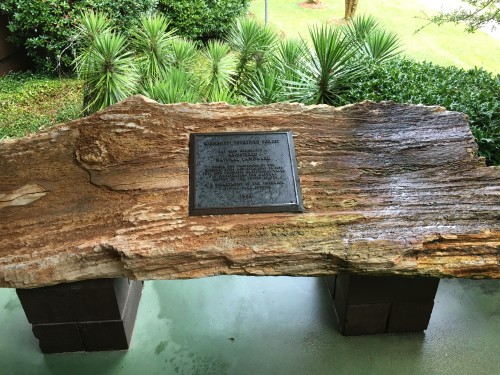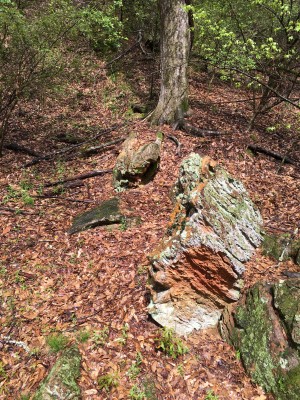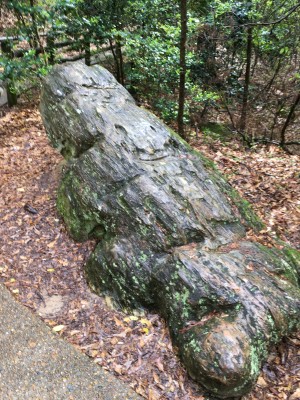During the week of spring break (March 21 – 25, 2016), my wife and I visited various areas in Mississippi and Missouri. I thought it might be interesting to review some of the places we visited instead of focusing on technology for the next couple of entries. Since the main purpose of our trip was to visit the petrified forest in Mississippi, I wanted to focus on that first. Until last year, I always thought of Arizona when someone mentioned a petrified forest. It turns out there is also one located near the town of Flora, MS. Although this was formed in a similar manner to the one in Arizona (petrified log jam in a large river), the petrified forest in Mississippi is much younger (only 36 million years old).
These petrified logs were deposited during the Oligocene Epoch (roughly 36 million years ago). They are found in sands of the Forest Hill Formation. They were likely rapidly buried and the organic materials were gradually replaced with minerals. Many logs lack branches (indicting they likely traveled a significant distance in a river and were subjected to much damage before arriving in their present location). Some of the individual logs measure 8 to 10 feet in dimeter. If you are curious, most petrified wood weighs 166 pounds per cubic foot. The Forest Hill Formation varies in depth from 40 to over 100 feet. It is suspected that many petrified logs remain buried. For example, a water drilling operation nearby in 1962 struck (and drilled through) a petrified log at a depth of 75 feet.
Here are a few photos of the petrified wood.



The first identification of petrified wood from this locality was in 1888 by F. H. Knowlton (a species of Palmoxylon). Other types of wood are sequoia like, oak, maple, fir, and Floroxylon variabilis (named for the nearby town of Flora) by L. H. Rapp in 1945.
Here is a slideshow of some of the photos I took of various pieces of petrified wood in the area. Note, this slideshow will open in a new browser tab/ window.
The Mississippi Petrified Forest is privately owned. It was designated a National Natural Landmark in 1966 and no petrified material may be collected from the park (although there are many areas adjacent to the park where local residents also find petrified wood).
I used my GoPro to take a number of photos as we walked the main trail through the park. I thought you might like to experience these slides as part of a video with some background nature.
I hope you enjoyed this brief overview of our tour of the Mississippi petrified forest. I plan to next focus on our time on the Natchez Trace.
As always, I look forward to your comments.


Dear Mark,
Thank you for posting this entry about the material from Flora, Mississippi.
I wanted to make a slight correction to your entry. Lawrence H. Rapp was a graduate student at the University of Cincinnati and it was in his 1954 Master of Science thesis in which he named the new species Floroxylon.
Lawrence’s material was part of the University of Cincinnati’s Paleobotanical Collection which we (the Cleveland Museum of Natural History, Cleveland, Ohio) received in 1980. His original labels are on the specimens he studied.
It is so nice to see the site from where our specimens were collected even if the collecting was decades before your photographs.
Many thanks for the additional information. I am glad you enjoyed the article.
Best always,
Mark
Dear Mark,
I wanted to update you on the Lawrence H. Rapp 1954 University of Cincinnati thesis on the material in Flora, Mississippi, Some Petrified Woods from Mississippi, which was for his Master of Science degree. There is another scientific paper on some of the material in Rapp’s thesis. The paper is The Structural and Phytogeographic Affinities of Some Silicified Wood from the Mid-Tertiary of West-Central Mississippi, by Will H. Blackwell and David M. Brandenburg (of Miami University, Oxford, Ohio), in Geobotany II, 1981, editor Robert Charles Romans.
Hi Paulette:
Many, many thanks for making me aware of these updates. I am most appreciative.
Best always,
Mark